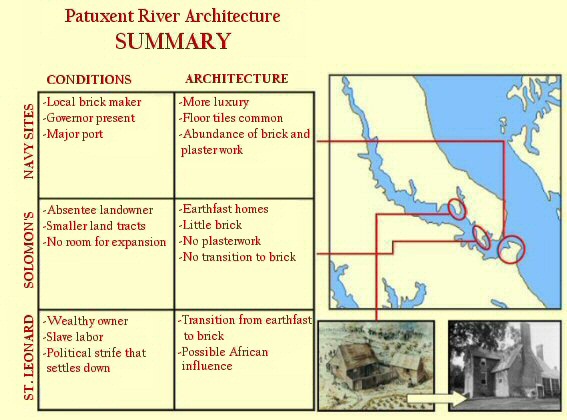17th & 18th Century Architecture Along the Patuxent River, MD
Essay by Sara Rivers Cofield, 2007
Conclusion
By concentrating on three areas, I have only discussed a fraction of the wealth of architectural data for the period 1631 to 1730 along the Patuxent River in Maryland. Each area touches upon themes cited in Carson et. al.’s 1981 article on "impermanent architecture," and they illustrate those themes in the context of small communities.
The NAS PAX sites stand out as having more brick, plaster, and tile work than the other early sites along the Patuxent. The presence of a brick maker might have facilitated access to these materials, but it must also be noted that the neighbors and relatives of the Governor might have felt compelled to spend a little more on their houses than did more isolated planters. These individuals probably would have had more exposure to luxury items because of the ships that came in to port at Mattapany, and also because skilled individuals may have gathered around their biggest potential client. By contrast, more isolated settlers of all degrees of wealth, from Richard Smith, Jr. to the unidentified tenants in the Solomon’s area, did not share the level of access or the proximity to high society that might have motivated them to employ a similar architectural standard. At Solomon’s, the group demonstrates that when land and skilled labor are not plentiful and tenants do not own the structures they live in, architecture stays pretty much the same, with inhabitants choosing to maintain no-frills earthfast structures until the sites were abandoned. By contrast, Richard Smith, Jr., as a wealthy land owner and slaveholder, did have a chance to upgrade his plantation once political strife calmed down and the economy picked up, and in his home we finally see brickwork move up the Patuxent.
Overall, the nine sites show that individual circumstances and neighborhood communities operated within larger regional contexts to influence the variations in earthfast construction and the differential use of brick construction along the Patuxent River. Common among all of the sites is that variability in access to skilled labor and to the power structure (both in terms of ownership, and in terms of political stability) leads to variability in architecture.

If you have any questions or comments about this article, or sites and artifact collections discussed, please contact:
[email protected].